The GIGABYTE Z170X-Gaming G1 Review: Quad-SLI on Skylake, and now with Thunderbolt 3
by Ian Cutress on December 1, 2015 9:30 AM EST- Posted in
- Motherboards
- Gaming
- Intel
- Gigabyte
- PLX
- PLX8747
- Z170
- Thunderbolt 3
CPU Performance, Short Form
For our motherboard reviews, we use our short form testing method. These tests usually focus on if a motherboard is using MultiCore Turbo (the feature used to have maximum turbo on at all times, giving a frequency advantage), or if there are slight gains to be had from tweaking the firmware. We leave the BIOS settings at default and memory at JEDEC (DDR4-2133 C15) for these tests, making it very easy to see which motherboards have MCT enabled by default.
Video Conversion – Handbrake v0.9.9: link
Handbrake is a media conversion tool that was initially designed to help DVD ISOs and Video CDs into more common video formats. For HandBrake, we take two videos (a 2h20 640x266 DVD rip and a 10min double UHD 3840x4320 animation short) and convert them to x264 format in an MP4 container. Results are given in terms of the frames per second processed, and HandBrake uses as many threads as possible.
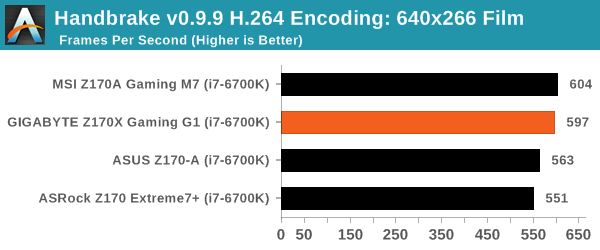
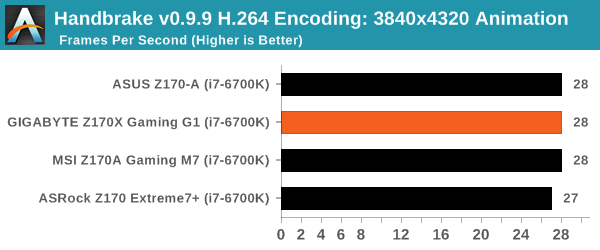
Compression – WinRAR 5.0.1: link
Our WinRAR test from 2013 is updated to the latest version of WinRAR at the start of 2014. We compress a set of 2867 files across 320 folders totaling 1.52 GB in size – 95% of these files are small typical website files, and the rest (90% of the size) are small 30 second 720p videos.
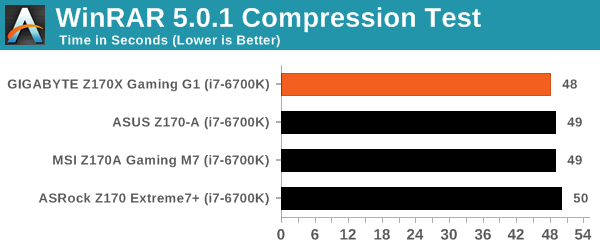
Point Calculations – 3D Movement Algorithm Test: link
3DPM is a self-penned benchmark, taking basic 3D movement algorithms used in Brownian Motion simulations and testing them for speed. High floating point performance, MHz and IPC wins in the single thread version, whereas the multithread version has to handle the threads and loves more cores. For a brief explanation of the platform agnostic coding behind this benchmark, see my forum post here.
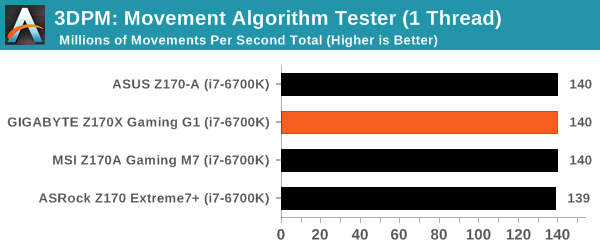
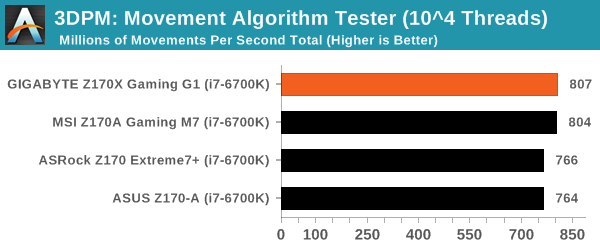
Image Manipulation – FastStone Image Viewer 4.9: link
Similarly to WinRAR, the FastStone test us updated for 2014 to the latest version. FastStone is the program I use to perform quick or bulk actions on images, such as resizing, adjusting for color and cropping. In our test we take a series of 170 images in various sizes and formats and convert them all into 640x480 .gif files, maintaining the aspect ratio. FastStone does not use multithreading for this test, and thus single threaded performance is often the winner.

Rendering – POV-Ray 3.7: link
The Persistence of Vision Ray Tracer, or POV-Ray, is a freeware package for as the name suggests, ray tracing. It is a pure renderer, rather than modeling software, but the latest beta version contains a handy benchmark for stressing all processing threads on a platform. We have been using this test in motherboard reviews to test memory stability at various CPU speeds to good effect – if it passes the test, the IMC in the CPU is stable for a given CPU speed. As a CPU test, it runs for approximately 2-3 minutes on high end platforms.

Synthetic – 7-Zip 9.2: link
As an open source compression tool, 7-Zip is a popular tool for making sets of files easier to handle and transfer. The software offers up its own benchmark, to which we report the result.
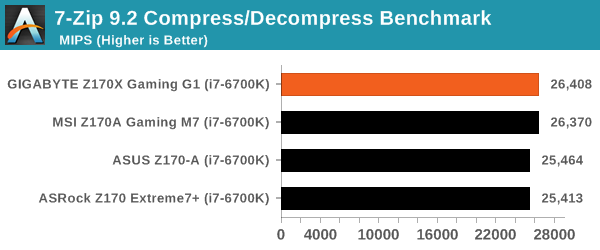










67 Comments
View All Comments
Ian Cutress - Tuesday, December 22, 2015 - link
I have four 290X cards? wow, where?I have the 4GB model, not four of them.
sor - Wednesday, December 2, 2015 - link
Agreed. The main reason to consider this thing is the x4 SLI. Too bad we have no idea what that looks like. Everything coming out of the review can be had for less on many other boards.jasonelmore - Tuesday, December 1, 2015 - link
Amazing looking board with the most I/O i have ever seen on a mainstream chipset.This would look sick with white tubing, in a corsair white case.
WasHopingForAnHonestReview - Wednesday, December 2, 2015 - link
Who fucking cares how it looks when the performance is subpar for the price?! What are you, an artist?!jasonelmore - Wednesday, December 2, 2015 - link
it's running a rev1 bios, and i'm not sure which performance your talking about.. All the benchmarks have it within 1 FPS, and that just boils down to variance. that's not even a 2% difference. DPC Latency is confirmed to be a intel wireless chipset and DRIVER problem, thus any board WITHOUT intel wireless doesnt have the DPC issues.linster - Tuesday, December 1, 2015 - link
Those "Quick Links to Other Pages" on page one don't work.TheEvilEngineer - Tuesday, December 1, 2015 - link
Ok, the board may be able to run a dual, triple, or quad SLI. However there isn't a skylake processor out with enough lanes to run that setup. The i7-6700k only has 16 lanes. At best, you can run a single GPU at full 16 lanes. Or dual with 8x and 8x. My personal setup on the board is a GTX 980 Ti (8x) and an intel 750 nvme drive (4x), with room for either a m2 or another intel 750. I'm not sure why they started including dual nics on consumer boards, they provide 0 benefit unless you some how have a business class 1+Gb/s internet connection. Best you can do with dual nics is configure them for smb 3.0 multi-channel.... though you'll need either another windows 10, 8.1 or server 2012 on your lan correctly configured as well to use it. I'd rather they just put in a 10 Gb/s nic instead.lilkwarrior - Thursday, December 3, 2015 - link
It's because of the PLX chip that comes with the card. It essentially extends the lanes available (& speeds) at the expense of cost & higher power consumptionJackie60 - Wednesday, December 2, 2015 - link
This is why Anandtech is losing it's way. Where is the 4 SLI bit of the review. Who would buy a $500 mobo for a CPU costing $300. Advertorial pure and simple.jasonelmore - Wednesday, December 2, 2015 - link
There are several other $500 Z170 Motherboards.. Asus's Maximus VIII Extreme for example.This has a expensive PLX chip, so it can do 16x0x16x0x or 8x8x8x8x. just fine. The PLX adds a tiny bit of latency, but nothing game breaking or noticeable.